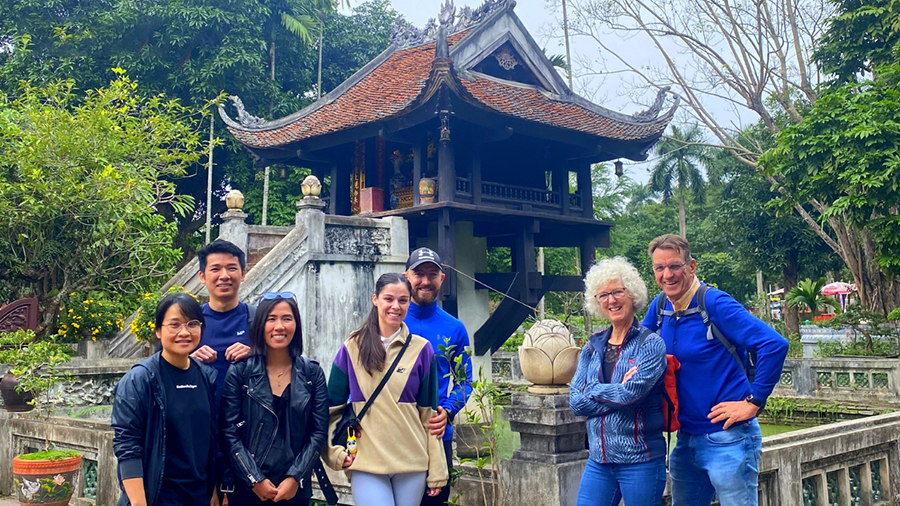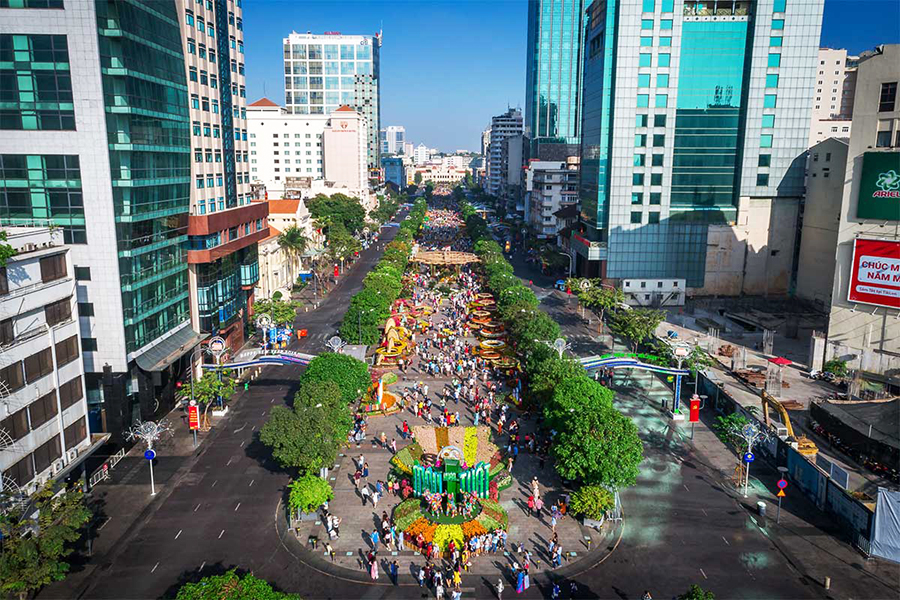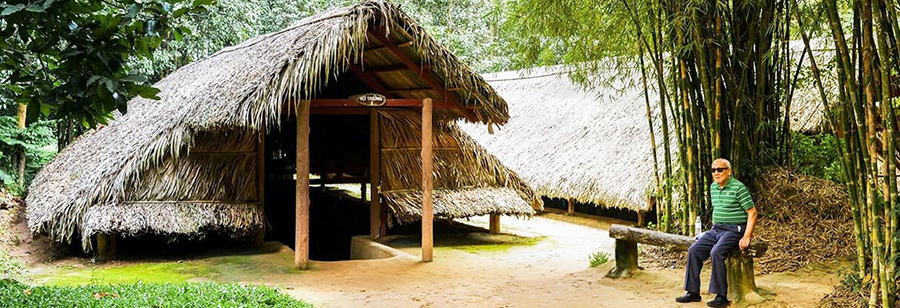Overview of One Pillar Pagoda
One Pillar Pagoda is a spiritual and cultural symbol of Hanoi with a thousand years of civilization due to bearing the architectural splendor hallmark of the famous historical dynasty in Vietnam. With special features in its structure along with historical values, the temple will surely be a real eye-opener for tourists.
Where is One Pillar Pagoda?
One Pillar Pagoda is located on the campus of the park behind Ong Ich Khiem Street, in Doi Can Ward, Ba Dinh District, Hanoi City. To the right of the pagoda is Ba Dinh Square, where majestic parades take place on major holidays in Vietnam, and Ho Chi Minh Mausoleum, the resting place of our beloved Uncle Ho.

One Pillar Pagoda History
Researchers indicated that between 1028 and 1054, during the Ly dynasty, Emperor Ly Thai Tong erected One Pillar Pagoda. According to the legend, Emperor Ly Thai Tong once had a dream in which the female Buddhist goddess, Quan Am Bo Tat, invited him to a lotus seat. He made the decision to construct a holy place in the shape of a lotus flower after explaining this tale to a monk, Thien Tue.
Due to its ability to bloom and spread its fragrance while emerging from a dirty environment, the lotus is revered in Confucianism and Buddhism as a representation of purity, prosperity, and wisdom. One Pillar Pagoda is regarded as the emperor’s sincere expression of thanks to Quan Am Bo Tat.
During the war in 1954, the One Pillar Pagoda was demolished by invaders’ bombs. Right after that, the government made a major restoration based on the drawings from the Nguyen Dynasty. Since then, the unique pagoda has been continuously embellished and preserved as a cultural, historical, and architectural heritage of our country.

Maybe you like:
One Pillar Pagoda Architecture
The distinctive features of One Pillar Pagoda’s architecture have become the eternal inspiration for many poems and articles throughout our history. Its specialty lies in the following features.
Lotus Station (Lien Hoa Dai)
One Pillar Pagoda possesses an exclusive architecture. Carrying the primary structure are eight wooden beams that represent eight flower petals. All joints were perfectly in alignment when the architecture was finished, making it exceedingly sturdy. It is erected on a large stone pillar, representing a lotus standing in the middle of Linh Chieu Lake.
The roof of the pagoda is covered with red brick scale tiles with four curved corners of the roof. Prominent on the roof of the pagoda is the exquisitely carved “double dragon adoring the moon”, an image that brings harmony to the universe and protects the sacredness of the pagoda.
It can be said that One Pillar Pagoda is a delicate combination of architecture, painting, as well as stone sculpture.

Three-arched-entrance Gate (Tam Quan Gate)
In the campus of One Pillar Pagoda, there is Three-arched-entrance Gate or Tam Quan Gate, with a horizontal painting depicting the three words “Dien Huu Pagoda.” This gate was originally built many years ago, but it was recently rebuilt to expand the scale of One Pillar Pagoda, creating a place for religious activities of monks and nuns, as well as welcoming tourists.

This majestic gate is placed in front of the temple in a very delicate way to help simulate the traditional architecture of Vietnamese pagoda.
The stairs leading to the main hall
To get to the main hall of Lien Hoa Dai, visitors will have to step through 13 steps with a width of about 1.4 meters. These steps were built a long time ago and still retain the architecture from the Ly Dynasty.
If the number 13 in Western culture represents bad luck and calamity, in Eastern culture, the number 13 represents fertility and prosperity. As a result, the 13 steps symbolize the temple’s blessings to pilgrims.

Lien Hoa Dai is the place to worship Quan Am Bo Tat. A rather large altar is located in the main hall, with a gilded statue of Buddha sitting on a wooden lotus, surrounded by worshiping objects such as candles, flowers, fruits and wine.
A bodhi tree that President Rajendra Prasad presented to President Ho Chi Minh is located in the pagoda grounds (Source: collected)
Another highlight of the One Pillar Pagoda is the Bodhi tree, presented by President of India Rajendra Prasad on the occasion of President Ho Chi Minh’s 1958 visit to India.
Along with the proliferation of this tree, the friendship between these two countries is strengthened.

One Pillar Pagoda Highlights
One Pillar Pagoda is a prominent name in a series of unique and iconic architectural works in Hanoi City. This Buddhist cultural imprint is located in the city center, so it is very convenient for people to come and visit. Therefore, going to Hanoi without paying this site a visit would be a real pity.

How much is the One Pillar Pagoda’s entrance fee?
For Vietnamese citizens visiting the One Pillar Pagoda, you will get free admission. However, for foreigners, the fee will be 25,000 VND per person.
Time to visit One Pillar Pagoda
Because it is located in Ho Chi Minh Mausoleum complex, the opening hours of One Pillar Pagoda depend on other parts of the area. Accordingly, to visit this unique temple, visitors are able to enter from 7 a.m to 6 p.m.
One Pillar Pagoda Map
How to get to One Pillar Pagoda in Hanoi?
Next to the pagoda is Ba Dinh Square. This is convenient for visitors to locate and find many means of transport.
If you have a motorbike or a car, you go to the location of the Ho Chi Minh Museum and park your vehicle at one of two locations:
- Ong Ich Khiem Street
- Ngoc Ha Street, next to Ho Chi Minh Museum
If you choose to take the bus, you can refer to some routes that pass-through Ba Dinh Square such as: 09, 33, 22, 45 and 50 and get off at stop 18A Le Hong Phong. This is the closest bus station to the mausoleum so you can easily walk to One Pillar Pagoda area.

Alternatively, you have the option to travel to One Pillar Pagoda by opting for the XANH SM Taxi service.
XANH SM Taxi
XANH SM Taxi – the first electric taxi company in Vietnam, operated entirely with VinFast electric cars. Customers who travel by XANH SM taxi not only receive an excellent standard of service, but they also join XANH SM in its efforts to reduce vehicle emissions and safeguard the environment. XANH SM provides standard and luxury taxi service, airport taxi, with attractive promotions. Customers can easily book a taxi in 04 ways:
(1) Call the national hotline 1900 2088
(2) Wave on the street like a traditional taxi
(3) Book on the Taxi Xanh SM app. Click HERE to download the app
(4) Use the beVinFast service on the multi-service customer platform BE to book Xanh SM taxi

For travelers who want to visit the One Pillar Pagoda with private services, you can book a private tour from Vietnam Shore Excursions. Professional and knowledgeable tour guides will share profoundly many interesting stories about this place and Hanoi, as well as the local life of local people during the tour. Here are some Hanoi Tours which customers can find out and book for you and your group.
In addition to the thrill that One Pillar Pagoda brings, tourists can explore other tourist attractions in Hanoi such as Hoa Lo Prison, Temple of Literature, Ho Chi Minh Mausoleum, Hanoi Old Quarter, Presidential Palace, Quan Thanh Temple, Hanoi Opera House,…
Unlike any Buddhist pagoda, One Pillar Pagoda carries a profound humanistic philosophy about life and the world. Its beauty not only seems like ancient majesty but also hides the elegant and gentle demeanor of Buddhism. Hopefully, the above information has helped you find the next destination for your trip.











